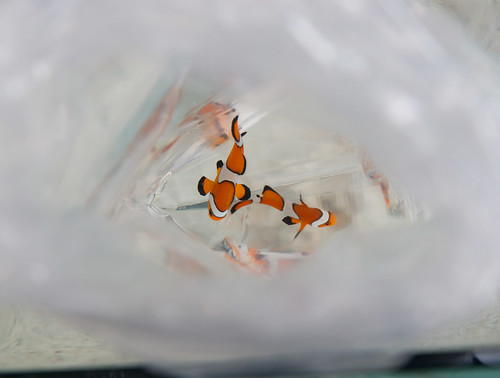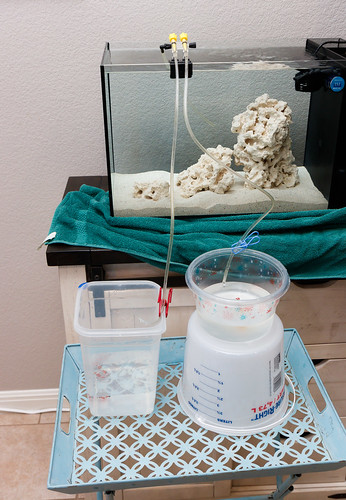With several months of planning and preparation behind us, it was finally time to add some fish to our EVO 13.5. The kids were excited to finally add some life to the tank!
I will talk about our process for planning livestock, picking a fish store, selecting fish, and acclimating the fish to their new home.
Deciding What Fish for Our Saltwater Nano:
Fish choices for a saltwater nano aquarium are limiting. I will make a separate page at some point to discuss good options for a small reef like the Fluval EVO.
For our EVO 13.5, we decided on a pair of clownfish. Clownfish come in many varieties of color and pattern and vary considerably in price as well. I saw all the variants, but to my eye, the common ocellaris clownfish were the most attractive.
I also decided to stock our tank with a skunk cleaner shrimp. One shrimp doesn’t add too much to the bioload and they add so much fun t0 a small tank.
Picking a Fish Store and Selecting Our Fish:
We have a couple of good fish stores in our area that were finalist in where we would procure our livestock. I think either would have been fine, but one stood out. The sales people there were not pushy and seemed very experienced. The tanks were clean and they had a large assortment of healthy and beautiful corals. I figured the store with the better corals probably had better overall knowledge and skills for reef tanks.
We had good fortune because the preferred store happened to have a large selection of juvenile clownfish to choose from when we were ready to stock our tank.
Prior to the day of purchase, I asked questions of the sales staff to make sure I understood the buying and acclimation process (that they recommend). I also asked about what temperature and salinity they keep their tanks at. Since our tank was void of life, I could adjust our aquarium a bit before hand to match. As it turns out, their temperature and salinity almost exactly matched ours. (both at 78°F [25.6°C]; salinity at 1.025 SG for their tank and 1.026 SG for ours).
The store had the clownfish displayed in pairs. However, we chose two fish from different pairs. One was slightly larger, which I had read was beneficial when pairing (the larger will likely develop into the female of the pair). The sales person agreed that our chosen two clownfish would have a high likelihood of pairing (develop from juveniles into one female and one male) and doing well together. Even if you are not a fish expert, observe the fish options and use your intuition to pick the fish that has attractive coloration, looks healthy, and has desirable behavior.
If you make the trip and the selection is not good, don’t be afraid to say no and wait for better stock another day. Saltwater fish can live along time, so you want to be happy with your selections.
With our success in selecting the fish and shrimp, into bags they went – and off we went to head home and get them ready for their new abode.
Acclimating New Fish to Our Saltwater Nano:
Here are some basic instructions on how to acclimate new fish to your saltwater tank. It’s very similar to acclimating fish in freshwater, but I will add a few things specific to saltwater.
Prior to adding your fish, make sure your tank is cycled and that your water conditions are good for the new fish. This might include performing a large water change (to lower nitrates) a day or two prior. As mentioned earlier, check that the aquarium’s temperature and salinity are on target.
For reference, we added our fish 17 days after we added water. However, the cycling process is different for everyone depending on a myriad of variables. Don’t rush it – make sure that your beneficial bacteria is established.
Transport – Protect and Insulate:
Not much to say about getting the fish home, other than a few common sense basics:
- Fish are typically sent home from the store in bags. At a minimum, have a cardboard box or similar to set the bag(s) in so they don’t roll around.
- Even better than a box, bring a cooler or insulated bag. This will help the fish hold stable their current temperature.
- Plan the trip to be as short as possible. Don’t go grocery shopping on the way home.
Float the Bags – Temperature Acclimate:
Temperature is the most important parameter to match between the water in the bags and your tank. It’s also the easiest.
Remove the tank cover/lid and float the bag(s) in the tank. Set a timer for 15 to 20 minutes.
Get Critters Out of the Bags:
Now is a good time to get the fish/critters out of the bag. Get an aquarium safe container and set the bag inside. Getting the fish out is easy – just take a pair of small scissors and cut down the side of the bag (top to bottom).
The water will quickly flood out. Continue cutting the bag away, then wrangle / herd the fish out away from the plastic as you pull the bag out of the water.
Drip Acclimate (Optional):
There is some controversy over the need to ‘drip acclimate’ your fish prior to adding them to your saltwater tank. Drip acclimation is any process where you slowly add your tank water to the separate fish container. The idea is that, similar to temperature acclimation, you can slowly acclimate the fish to other water parameters (salinity, ph, alkalinity, etc.).
I think it makes sense to drip acclimate; however, I think it can be detrimental if it takes too long.
My drip acclimation is less of a drip and more of a quick dribble. I start slow and speed up the water transfer rate toward the end. My goal is to double the container’s water volume over 30-40 minutes.
I use aquarium airline tubing and a two-way gang valve
. Start a siphon with your mouth to start moving water from the aquarium to the fish container. Adjust the valve to flow at the rate you want.
As you transfer water, you will need to juggle two things. First, discard water if the level gets too high in the fish container. Second, replace water in the aquarium as it gets depleted. If you have an ATO (Auto Top Off) system, turn it off during this process to keep makeup water from diluting the tank.
Note: if you get your fish online and they are mailed to you, follow the retailer’s instructions for acclimation – they often direct to not drip acclimate and instead only temperature acclimate (bag float).
Wrangle the Fish:
Showtime! Time to move the fish to the aquarium.
The best way is to avoid using a net and instead, herd the fish into another smaller container that you use as a scoop (to then plop into the aquarium). You can even just use a hand to scoop the critter out to plop into the aquarium. Try to move as little of the fish store water to the tank as possible.
Using a net can stress the fish and you have a higher chance of injuring their fins. I didn’t have luck with the scoop and plop method and had to resort to a net. It worked fine and the fish were perfectly healthy in their new home.
Enjoy Your New Saltwater Fish:
Our family spent many fun hours watching our new saltwater fish that first evening. The two clownfish and the skunk cleaner shrimp displayed a much higher level of mobility and intelligence than I had ever seen from fish in our freshwater nano.
Even though clownfish are considered somewhat common (among saltwater fish), I find myself astounded by their beauty and movement.
For the first few days and weeks, work to maintain stability in water parameters (temperature and salinity), start your maintenance regimen (which I will discuss in an upcoming series article), and start feeding the livestock. Speaking of feeding your fish. . .
Next in the series is Part 11: Feeding Fish in Your Saltwater Nano.














Awesome! Glad to see you posting again
My clown fish died in the bag during transport. Got it at Petrovna
I’m so sorry. I feel comfortable with shipping some critters (snails, pods, etc.) but fish is taking it to a whole new level. Glad I had a shop to purchase from locally as that is much less stressful (to fish and their new owners).